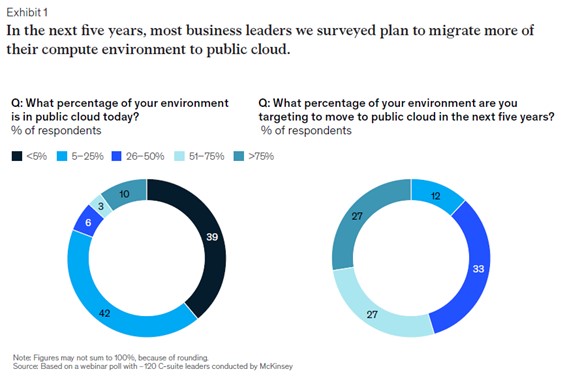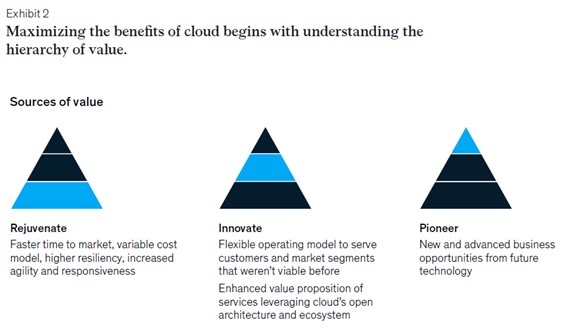15.02.24
The Cloud: Accessing Value for Insurers

We all know about the increased adoption of the cloud by every sector of the economy. Many things are said on the topic and the reason and benefits of this trend are not always clear to the non-initiated public.
A recent survey by McKinsey[ii] indicates that by 2027, 54% of business leaders plan to have more than half of their computing environment on the public cloud (versus 13% that have it today).

Ultimately, it is the customers – or the desire to give them the best possible experience – that is the groundswell of this movement.
As discussed in Customer experience in the driver’s seat of insurance transformation, in today’s connected world shaped by the GAFAMs, clients have come to expect a flexible and personalized experience, by which all service providers interact with them in a digital, seamless, and autonomous way. To meet these evolving customer expectations, the digitization of society is constant. This in turn leads to greater data generation and a steadily increasing number of data processing issues that can only be solved in cloud environments. The provision of constantly increasing computing power with sufficient capacities is nevertheless by no means the only driver of cloud development. Just as important is the fact that many of the most innovative methods of data analytics are available first and foremost in the public cloud.
In 2017 already, Bain & Company and Google identified seven key technologies that had begun to disrupt the industry and whose impact they predicted would accelerate in the next years[i]. These technologies —namely, infrastructure and productivity, online sales technologies, advanced analytics, machine learning, the Internet of Things, distributed ledger and virtual reality— are mostly available in the cloud and continue to progress and generate data.
While in the past, to use such programs or applications, software needed to be loaded onto a computer or located on a physical server in the same building, Cloud computing eliminates this need (and the associated costs), allowing users to access the same programs from any location, thanks to the internet.
The tangible benefits of cloud technology are thus: easy access, reduced costs, increased performance, scalability, reliability, and security. However, the most important thing to understand about the cloud, is that it’s not a more efficient way to operate IT, but a force multiplier for generating value for the business.
McKinsey[i]says the business units most effective in capturing the cloud’s value focus on two key areas: understanding where the value in the cloud lies and building a partnership between business and IT. As illustrated by the exhibit below, the organization will then derive value from rejuvenation – focusing on cost and risk reduction led mainly by IT – and innovation – where business and IT look at the cloud to accelerate or enable the development of new revenue streams.

Successful cloud migrations depend on knowing where the value for insurance lies in cloud and on business and IT working together.
McKinsey figures[i] that the rejuvenation of cloud adoption by itself enables carriers to standardize, automate and benefit from:
- 30 to 40% reduction of IT overhead costs
- Optimized IT asset usage by scaling processes up and down as needed
- Improved overall flexibility of IT in meeting business needs through the use of business features made available by cloud providers
Sibylle Fischer, Director Strategic Venturing / Startup Scouting at Baloise Group, is right when she says[ii]: « today, cloud-based software and software platforms, open-API technologies, microservices, machine learning and A.I. are all helping to redefine everything we know about insurance — from the way we onboard customers, to how we process claims, to how we sell products and services. »
Simply put, the cloud is the distribution of essential services such as servers, databases, and software via the internet. Making available services such as storage, processing, and data transmission to users in an on-demand mode, the cloud is having a huge impact on the insurance industry. Most important is that its impact on the organization is transversal, from benefits for internal processes to enabling new customer acquisition, and policyholder loyalty. To realize and exploit the potential of the cloud, business leaders need to ensure all executives in the company understand what is at stake and be involved.
Sources
[i] In: McKinsey & Cy, Reaching the next normal of insurance core technology, June 2020
[ii] In: What’s Next for Innovation in Core Insurance
Cloud computing: Where the insurance industry really stands, From <https://isg-one.com/articles/cloud-computing-where-the-insurance-industry-really-stands>
[i] Digitalization in Insurance: The Multibillion Dollar Opportunity
[i] In: McKinsey – What every insurance leader should know about cloud, Successful cloud migrations depend on knowing where the value for insurance lies in cloud and on business and IT working together, Sept. 2022
[ii] In: McKinsey – What every insurance leader should know about cloud, Successful cloud migrations depend on knowing where the value for insurance lies in cloud and on business and IT working together, Sept. 2022